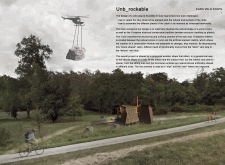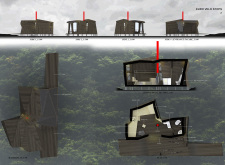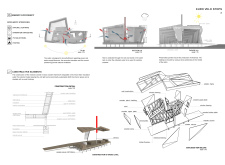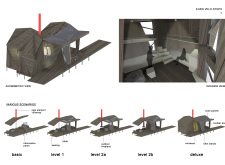5 key facts about this project
At its core, the project functions as a multifaceted space designed to accommodate a variety of activities. Open-plan areas promote social interaction and collaboration, while designated private spaces offer tranquility and retreat. The interplay between these zones is carefully crafted to ensure that users can transition seamlessly from one to another, highlighting a prioritization of user experience in the design process. Elements such as natural light and ventilation have been integrated to enhance the overall atmosphere within the building, creating a welcoming environment that feels both spacious and intimate.
The architectural design incorporates a range of materials that not only fulfill practical requirements but also enhance the visual quality of the construction. The use of reinforced concrete provides structural integrity while serving as a durable façade. High-performance glass has been strategically employed to allow for expansive views and daylighting, optimizing energy efficiency without compromising aesthetics. Sustainably sourced wood elements weave warmth into the interior, creating a sense of comfort that complements the more industrial materials used throughout.
Notably, the project employs innovative design techniques that distinguish it from typical architectural practices. This includes features such as green roofs that contribute to stormwater management and biodiversity, demonstrating a commitment to environmental sustainability. Additionally, the incorporation of passive design principles maximizes energy efficiency, reducing reliance on artificial heating and cooling systems. These approaches reflect a forward-thinking mindset in architectural design, where ecological considerations are woven into the fabric of the project.
Attention to detail is evident in various aspects of the design. From carefully positioned windows that frame views of the surrounding landscape to thoughtful placements of built-in furniture that optimize space utilization, the project demonstrates a high level of craftsmanship. The landscaping around the structure is equally essential, using native plant species to enhance ecological integration and minimize maintenance. This synergy between built and natural environments underscores a holistic approach to architectural design.
The project’s unique character is simultaneously rooted in contemporary architectural trends and responsive to the cultural context of its location. This nuanced approach allows the design to resonate not just with its immediate users, but also with the surrounding community. By fostering a sense of belonging and connection to place, the project reinforces the idea that architecture can indeed serve as a catalyst for social interaction and community building.
As one delves deeper into the specifics of the project, the architectural plans and sections reveal the thoughtful consideration given to every element. The layout showcases a strategic balance between openness and enclosure, providing insights into the functional relationships between spaces. Various architectural ideas presented throughout the design illustrate a cohesive narrative that ties together form, function, and environment.
In engaging with this project, individuals are invited to explore the various dimensions of its architectural designs, including the innovative materials used and distinctive features that define its character. The intention behind every decision is rooted in functionality and sustainability, offering a well-rounded perspective of contemporary architecture. For those interested in understanding how these ideas translate into practical applications, reviewing the architectural plans and sections will provide a comprehensive view of the design’s intentions and outcomes. The project stands as a testament to the potential of architecture to enhance everyday life while respecting the environment.


























